Disclosure: We may earn commissions if you purchase products after clicking on a link from our site.
Still hunting for deer is one of the hunting methods used by hunters. It involves moving slowly and blending in with the terrain. Hunters utilize heavy cover, and shadows, and stay aware of their surroundings when still hunting for deer.
Additionally, make sure to get stealth gear, camouflage clothing, and a good hunting rifle. In this article, we discuss the still hunting techniques that will improve your chances of a successful deer hunt.
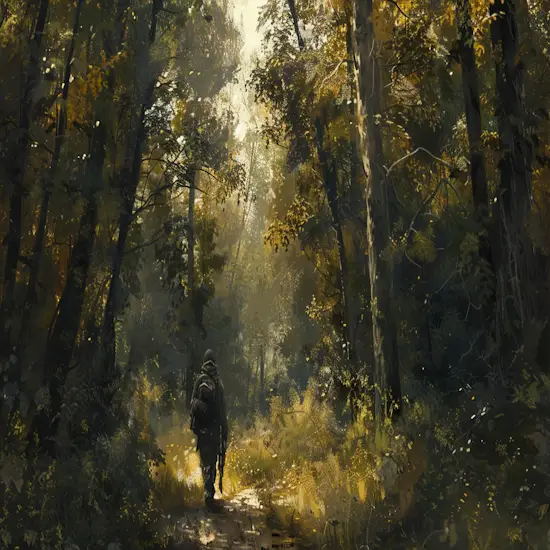
Table of Contents
- 1 Key Takeaways
- 2 Mastering Still-Hunting Techniques
- 3 Essential Equipment for Still-Hunting
- 4 Successful Still-Hunting Strategies
- 5 Leveraging Wind for Still-Hunting
- 6 Tracking Deer for Success
- 7 Navigation Tips for Still-Hunters
- 8 Effective Hunting Techniques
- 9 Gear and Gear Preparation
- 10 Shot Readiness and Execution
- 11 Clothing and Packing Tips
- 12 The Bottom Line
Key Takeaways
- Utilize terrain and shadows for stealth.
- Monitor wind direction to stay downwind of deer.
- Track fresh deer tracks for recent activity.
- Focus on dawn and dusk for deer movement.
- Wear camouflage gear and move slowly.
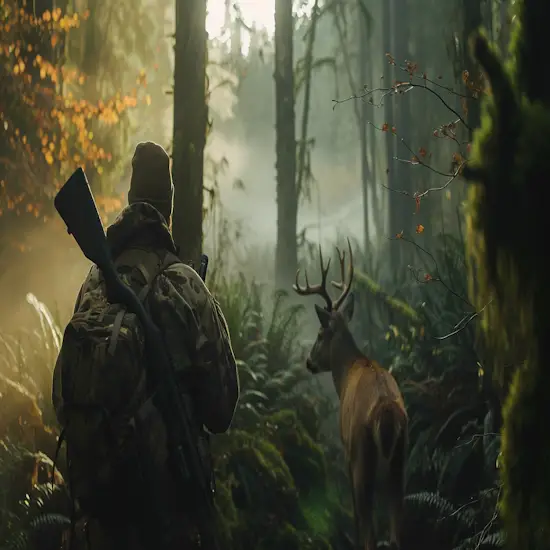
Mastering Still-Hunting Techniques
To master still-hunting techniques effectively, you should approach big whitetails slowly and stealthily, utilizing terrain and shadows to your advantage. Be patient to guarantee perfect shot opportunities and be ready to adapt to changing conditions for success.
Slow and Stealthy Approach
Moving slowly and utilizing cover and shadows are essential elements of mastering still-hunting techniques for a successful deer hunt. When you move slowly, you blend in with your surroundings, making it harder for a mature buck to detect your presence.
By using natural cover and shadows, you can remain hidden and increase your chances of a successful hunt. Remember to stay aware of your surroundings, adjusting your pace based on deer signs and terrain.
Being stealthy and patient is key to outsmarting a big buck and getting closer for a good shot. So, take your time, use the available cover wisely, and move with caution to increase your chances of a successful still-hunting experience.
Terrain and Shadows Utilization
Utilize the natural terrain features and shadows to your advantage when mastering still-hunting techniques for hunting whitetail deer. Use the terrain to hide your movements and stay out of sight. Walk along ridgelines to silhouette yourself against the sky. Move through a thick brush to break up your outline.
Shadows can help you blend in and remain unnoticed. Use them to your benefit, especially during low-light conditions. Stay aware of the sun’s position to predict where shadows will fall. By understanding and utilizing the terrain and shadows effectively, you can increase your chances of getting closer to deer without being detected. Mastering this skill will greatly enhance your still-hunting success.
Patience for Optimal Shots
Exercise patience while honing your still-hunting skills for best shot opportunities during white-tailed deer hunting. Mastering the art of still-hunting requires a calm and patient approach to guarantee prime shots. Take your time, stay focused, and be ready for the perfect moment to present itself. Remember, patience is key to success in still-hunting.
| Patience Tips For Prime Shots | Explanation |
|---|---|
| Move slowly | Allows for better observation and stealth |
| Take breaks | Rest and observe your surroundings |
| Stay alert | Be ready for any sudden opportunities |
| Control your breathing | Stay calm and focused for accurate shots |
| Be patient | The right shot is worth the wait |
Adapting to Changing Conditions
When adapting to changing conditions while mastering still-hunting techniques, whitetail hunters should stay flexible and observant. Be prepared to adjust your pace, route, and approach based on the environment and deer behavior.
Utilize shadows, terrain features, and weather patterns to your advantage. Stay patient and persistent, adapting to make the best of each situation. Monitor wind direction closely and adjust your movements accordingly.
Use natural noises to your advantage, pausing after making noise to stay alert for potential shot opportunities. Stay focused, move slowly, and be aware of your surroundings to increase your chances of success. Adapting to changing conditions is key in mastering still-hunting techniques.
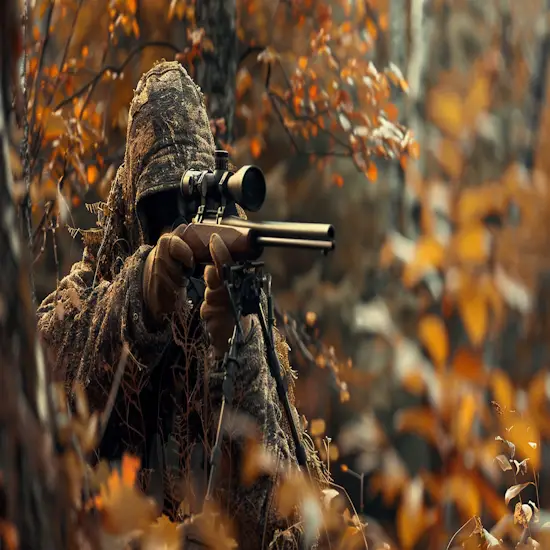
Essential Equipment for Still-Hunting
When still hunting, it’s important to equip yourself with gear that enhances stealth and comfort. Make sure you carry only the minimal essentials for a lighter, more agile approach. Opt for camouflage attire that not only conceals you but also provides comfort during long hours in the field.
Gear for Stealth
For successful still-hunting, equipping yourself with essential gear for stealth is paramount. Here are three key pieces of gear to enhance your stealth while pursuing deer:
| Gear | Description | Importance |
|---|---|---|
| Camouflage Clothing | Blend with surroundings | Essential for concealment |
| Quality Binoculars | Scout from a distance | Spot deer without alerting them |
| Quiet Boots | Move silently | Avoid startling deer |
Having the right camouflage clothing to blend seamlessly into your surroundings is vital for staying hidden. Quality binoculars allow you to scout deer from long distances without disturbing them. Quiet boots help you move stealthily through the terrain, minimizing noise that could scare off your target. Choose your gear wisely to improve your chances of successful still-hunts.
Minimal Essentials
Equip yourself with only the most necessary items for successful still-hunting by focusing on the minimal essentials. Opt for lightweight and quiet gear to enhance your mobility and stealth. Carry a reliable rifle with a scope set at or below 4X for accurate shots.
Wear a ghillie suit for effective camouflage and choose boots that allow for silent movement. Use binoculars for scouting and identifying targets. Utilize a fanny pack to carry essential items without adding excess weight.
Prioritize items that aid in stealth and comfort, such as quiet clothing and equipment that won’t hinder your movements. By keeping your gear minimal and purposeful, you increase your chances of a successful still-hunting experience.
Camouflage and Comfort
To enhance your still-hunting experience, prioritize comfortable and effective camouflage gear. Ensuring you blend seamlessly into your surroundings while staying comfortable is key to a successful hunt. Here is a helpful table outlining essential camouflage and comfort gear:
| Camouflage and Comfort Gear | Description |
|---|---|
| Camouflage Clothing | Wear high-quality camo gear that matches your hunting environment. |
| Ghillie Suit | Consider a ghillie suit for ultimate camouflage and versatility. |
| Comfortable Boots | Choose quiet, comfortable boots for long hours of still hunting. |
| Face Paint or Mask | Use a face paint or mask to conceal your face effectively. |

Successful Still-Hunting Strategies
To have great success in still-hunting, focus on mastering movement and stealth, utilizing terrain to your advantage, staying aware of wind direction, managing noise effectively, and ensuring you have the right equipment essentials.
Movement and Stealth
For mastering still-hunting, slow and deliberate movements are essential to guarantee success in tracking and approaching deer with stealth and precision. Here are some tips to help you improve your movement and stealth techniques:
| Movement and Stealth Tips |
|---|
| Walk silently |
| Use shadow for cover |
| Stop frequently to listen |
Terrain Utilization
Utilize the natural features of the terrain to your advantage when still hunting for deer. Use the landscape to mask your movements and stay hidden from deer. Move slowly and purposefully, using trees, rocks, and dips in the terrain as cover.
Be mindful of the direction of the sun to cast shadows that help conceal your presence. By blending into the surroundings, you increase your chances of spotting deer before they spot you.
Pay attention to the ground cover to minimize noise and avoid stepping on crunchy leaves or twigs. Remember, the terrain is your ally in the art of still-hunting, so make the most out of its features for a successful hunt.
Wind Direction Awareness
Maintain constant awareness of wind direction when still hunting for deer to enhance your chances of a successful hunt. Wind plays an important role in carrying your scent to deer, potentially alerting them to your presence. To maximize your effectiveness:
- Continuously monitor the wind’s direction to make sure you’re staying downwind of deer.
- Use a wind checker every 5-10 minutes to gauge wind patterns accurately.
- Adjust your movements based on the wind’s direction to maintain stealth and avoid detection by deer.
Noise Management Techniques
Continuously pause and listen after making noise while still hunting to enhance your chances of spotting deer. Stop immediately to blend in with the surroundings. Take at least five minutes before moving again.
Stay alert, scanning for any movement or sound. Being still allows you to detect deer that might’ve been startled. By listening carefully, you can anticipate their next move. Remember to stay patient and composed during this waiting period.
This technique is essential for maintaining stealth and increasing your chances of a successful still hunt. Stay focused and ready for any sudden opportunities that may arise while you’re silently observing the surrounding area.
Equipment Essentials
After mastering noise management techniques, and ensuring you blend in seamlessly with your surroundings, the next step is to understand the equipment essentials crucial for successful still-hunting strategies.
Equipment Essentials:
- Wear the right amount of clothes: Dress appropriately for the weather to stay comfortable and avoid unnecessary noise.
- Pack only the essentials: Travel light to remain agile and stealthy during your still-hunting expeditions.
- Avoid bulky, heavy gear: Opt for lightweight equipment to move quietly and swiftly through the terrain.
Choosing the right gear can make a significant difference in your still-hunting success. Keep it simple, stay light on your feet, and focus on essentials to enhance your hunting experience.
Tracking for Success
For successful still-hunting strategies, mastering the art of tracking is essential. To track deer successfully, follow their prints diligently, even if they’re old. Tracks often lead to areas with high deer activity, especially near watercourses.
Trails close to water sources are prime spots for still-hunting. Utilize your navigational tools like GPS and maps for efficient tracking. Stay focused and concentrated on the trail. Remember, deer behavior can change based on weather conditions, so adapt your tracking techniques accordingly.
Weather Impact on Hunting
To optimize your success in still-hunting, understanding how weather conditions influence deer behavior is essential.
Weather Impact on Hunting
- Deer Activity and Precipitation: Deer activity rises during precipitation, affecting movement patterns.
- Specific Areas during Windy Weather: Look for deer in specific areas during windy weather for better chances of spotting them.
- The benefit of Light Rain or Snow: Light rain or snow can help conceal sound, scent, and motion, making it easier to approach deer unnoticed.
Understanding these weather-related factors can greatly improve your still-hunting success. Stay mindful of the weather conditions and adapt your strategies accordingly to increase your chances of a successful hunt.
Traversing through the wilderness while upholding concentration is essential for successful still-hunting strategies. To navigate effectively, stay focused on your surroundings, utilizing maps, GPS, and landmarks. Keep your attention sharp, scanning for any movement or signs of deer.
Stay aware of your surroundings, adjusting your path based on the terrain and wind direction. Maintain concentration to avoid missing critical opportunities. By honing your focus and navigation skills, you can increase your chances of successful still-hunts.

Leveraging Wind for Still-Hunting
When still hunting, you must pay attention to the wind’s direction. Be cautious of your scent cone and adjust your movement strategies accordingly. Always position yourself downwind of the deer for a higher chance of success.
Wind Direction Importance
Utilizing the wind direction can greatly improve your still-hunting success by enabling you to stay undetected by deer. Always position yourself downwind from where you expect deer to approach.
Additionally, constantly monitor wind direction using a wind checker every 5-10 minutes. Also, adjust your movements and positioning based on the current wind direction to maintain stealth.
Scent Cone Awareness
To maximize your success in still-hunting, understanding and leveraging the concept of scent cone awareness is crucial. By being conscious of the direction in which your scent travels, you can strategically position yourself to stay undetected by deer. Here’s a simple guide to help you visualize the concept:
| Wind Direction | Your Position | Deer’s Position |
|---|---|---|
| Coming from | Behind | Front |
| Blowing towards | Side | Front |
| Blowing towards | Front | Behind |
Being mindful of the scent cone allows you to adjust your movements accordingly, ensuring that you remain downwind of the deer. This awareness can significantly increase your chances of a successful still hunt.
Adapting Movement Strategies
Adapt your movement strategies by leveraging the wind effectively for still-hunting success. Here are three key tips to help you make the most of wind direction:
- Constant Monitoring: Keep tabs on the wind’s direction and strength throughout your hunt.
- Frequent Checks: Use a wind checker every 5-10 minutes to make certain you stay downwind of the deer.
- Adjustment: Be cautious of your scent cone and make necessary movements based on the wind direction to maintain the element of surprise.
Deer Downwind Positioning
Position yourself downwind of the deer to leverage the wind effectively for successful still-hunting.
| Deer Downwind Positioning Tips |
|---|
| Monitor wind direction |
| Use wind checker frequently |
| Be cautious of your scent cone |
| Stay downwind of deer |
| Adjust movements based on wind |

Tracking Deer for Success
To track deer successfully, follow their tracks, especially leading to watercourse hunting areas, where deer are commonly found. Understanding deer movement patterns helps you locate high-activity zones where deer frequent.
Follow Deer Tracks
Follow the deer tracks to increase your chances of hunting success. Tracking deer can lead you to prime hunting spots. Here are three key points to remember:
- Fresh Tracks Mean Recent Activity: Look for tracks that are well-defined and not yet filled with debris. Fresh tracks indicate that deer have been in the area recently, increasing your chances of encountering them.
- Track Direction: Pay attention to the direction in which the tracks are heading. This can give you insights into where the deer are going and help you anticipate their movements.
- Track Patterns: Study the patterns of the tracks. Are they clustered in a specific area? Understanding the layout of the tracks can guide you toward areas with higher deer activity.
Watercourse Hunting Areas
If you’ve been tracking deer successfully by following their fresh tracks, the next step is to focus on hunting in watercourse areas to enhance your chances of a successful hunt. Watercourses such as streams, rivers, and ponds are natural attractions for deer due to the availability of water and lush vegetation.
Deer often use these areas for drinking, feeding, and moving, making them prime locations for still-hunting. When hunting near watercourses, look for well-used game trails leading to and from the water, and position yourself strategically to intercept deer as they come to quench their thirst or browse. Being near water increases your chances of encountering an unsuspecting buck and can lead to more successful stalks.
Deer Movement Patterns
Considering deer movement patterns can greatly enhance your tracking skills and increase your hunting success. Deer are most active during dawn and dusk, so focus your efforts during these times.
Additionally, always pay attention to natural funnels, such as saddles and ridge tops, where deer are likely to travel. Understanding bedding areas and food sources can help predict deer movement patterns throughout the day.
High-Activity Zones
To increase your chances of tracking deer successfully, focus on identifying high-activity zones where deer are likely to frequent. Look for areas with fresh tracks, droppings, or deer beds. Water sources like creeks and rivers are also attractive to deer. Trails near water are ideal spots for still-hunting.
Pay attention to dense vegetation and thick cover, as deer often seek shelter there. Utilize high-quality binoculars and wear a ghillie suit for camouflage. Choose quiet boots and remove rifle slings to avoid noise. Be prepared for quick-shot opportunities by finding a rest beforehand.
Practice essential skills and keep your scope at or below 4X for better accuracy. Hunt strategically, focusing on staging zones in the afternoon for increased success.
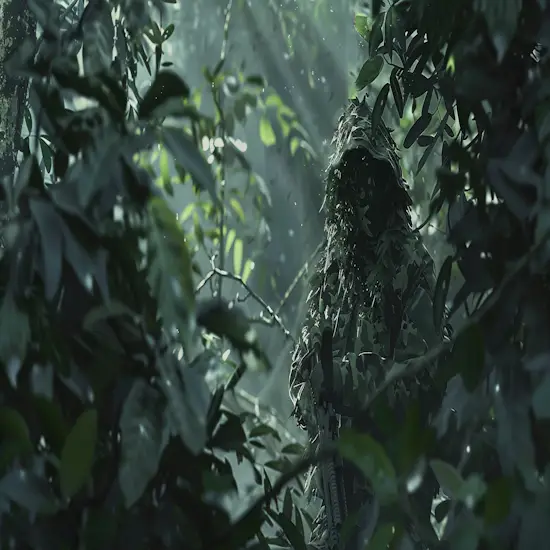
When still hunting, utilizing GPS for navigation, keeping detailed maps, taking notes, and focusing intently is essential for success.
Knowing deer movement patterns and being able to concentrate on your surroundings will greatly enhance your hunting experience. Stay prepared and observant to make the most of your still-hunting endeavors.
For still-hunters looking to enhance their navigation skills, utilizing a GPS device can be a valuable tool in plotting routes and tracking movements in the field.
- Pinpoint Locations: Mark important spots like deer sightings or feeding areas for future reference.
- Track Movements: Follow your path to avoid retracing steps and cover new ground efficiently.
- Monitor Weather: Use GPS features to stay updated on changing weather conditions that could affect your hunt.
Mapping and Notes
Enhance your navigation skills as a still-hunter by utilizing mapping and notes to track your movements effectively in the field. Study aerial and topo maps to plan your routes strategically.
Take notes of key landmarks, deer signs, and areas of interest to help guide your movements. Use your map to mark locations where you have spotted deer or found tracks to revisit later.
Focus and Concentration
To maintain focus and concentration while still hunting, regularly refer to your notes and map to stay aware of your surroundings. Here are three key tips to enhance your focus and concentration:
- Stay Present: Keep your mind focused on the hunt, avoiding distractions.
- Control Breathing: Take slow, deep breaths to stay calm and composed.
- Visualize Success: Picture yourself successfully tracking and taking down a deer to maintain motivation.
Deer Movement Patterns
Regularly referring to your notes and the map will help you stay aware of deer movement patterns while still hunting. Understanding the terrain and using your observations can aid in predicting where deer are likely to be at different times of the day.
Deer tend to move from bedding areas to feeding areas in the early morning and then back again in the late afternoon. During midday, they may seek shelter in thick cover. Pay attention to tracks, droppings, and other signs of deer activity to adjust your strategy accordingly.

Effective Hunting Techniques
When hunting for deer, remember the importance of stealth and patience. Always utilize the terrain to your advantage, staying aware of shadows and natural cover. Be mindful of the wind direction and master the art of blending in by making natural noises.
Stealth and Patience
For successful deer hunting, mastering the art of stealth and patience is essential. To improve your still-hunting techniques, remember these key points:
- Move slowly and adapt your pace based on the deer sign.
- Utilize wind direction to your advantage.
- Be prepared to break traditional rules for a more effective hunt.
Terrain Advantage
To maximize your hunting success, leverage the terrain to gain an advantage in your hunting techniques. When still hunting, understanding the landscape can greatly improve your chances of a successful hunt. Here is a simple guide to help you make the most of the terrain:
| Terrain Advantage Tips | Description |
|---|---|
| Study the Topography | Identify valleys and ridges |
| Utilize Natural Cover | Hide behind trees and bushes |
| Stay Low and Quiet | Keep a low profile and move stealthily |
| Use Hills to Stay Hidden | Position yourself for better visibility |
| Monitor Deer Movement | Predict where deer may travel |
Wind Awareness
Maximizing your hunting success involves a keen awareness of wind patterns and their impact on your hunting techniques. Wind can be your ally or your enemy when hunting deer, affecting your scent dispersion and potentially alerting the deer to your presence.
To make the most of wind awareness, consider the following:
- Monitor Wind Direction: Constantly assess the wind’s direction to position yourself downwind of the deer.
- Use Wind Checker Regularly: Employ a wind checker every 5-10 minutes to track any shifts in wind patterns.
- Adjust Movement Based on Wind: Adapt your movements accordingly, making sure to stay downwind of the deer to avoid detection.
Natural Noise Mastery
Mastering natural noises is essential for effective hunting techniques when pursuing deer. To blend in seamlessly with the environment, make noises that mimic the natural sounds of the forest. When walking, step lightly to avoid crunching leaves or snapping twigs.
If you accidentally make noise, freeze immediately and wait for at least five minutes before moving again. This technique helps you stay undetected by deer and increases your chances of a successful hunt.

Gear and Gear Preparation
When gearing up for deer hunting, remember the importance of:
- Selecting the proper gear
- Maintaining it properly
- Considering camouflage effectiveness
- Organizing your equipment efficiently
These factors can greatly impact your hunting success, ensuring you’re well-prepared and equipped for the challenges ahead.
Stay focused on these essential points to enhance your hunting experience and increase your chances of a successful deer hunt.
Essential Gear Selection
Choosing the necessary gear for your still-hunting expedition is crucial for your success in the field.
- Opt for lightweight and breathable clothing to guarantee comfort and mobility.
- Carry a compact backpack with essentials like water, snacks, a first-aid kit, and a multi-tool.
- Equip yourself with high-quality binoculars for scouting and spotting deer from a distance.
Selecting the right gear can make a significant difference in your hunting experience, allowing you to move effectively and stay prepared for any opportunities that come your way. Make sure to prioritize practicality, mobility, and functionality when choosing your gear for a successful still-hunting adventure.
Gear Maintenance Tips
To preserve your hunting gear in ideal condition for your still-hunting excursions, regular cleaning, and proper storage are essential practices. After each outing, clean your gear thoroughly to remove dirt, debris, and any moisture that could cause damage. Pay special attention to your weapon, optics, and clothing to guarantee they function properly and provide peak camouflage.
Store your gear in a dry, cool place to prevent mold, rust, or mildew. Check your equipment periodically for any signs of wear and tear, and address any issues promptly to avoid problems in the field. By taking these maintenance steps, you can ensure that your gear is always ready for successful still-hunting ventures.
Camouflage Effectiveness Factors
For peak camouflage effectiveness in deer hunting, make sure your gear is meticulously maintained and prepared to blend seamlessly with the natural surroundings. To enhance your camouflage effectiveness, consider the following factors:
- Gear Quality: Invest in high-quality camouflage gear that matches the environment you’ll be hunting in.
- Gear Cleanliness: Maintain your gear clean and scent-free to avoid alerting deer to your presence.
- Gear Fit: Guarantee your gear fits properly to prevent any unnecessary noise or movement that could give away your position.
Efficient Gear Organization
Prepare your gear efficiently to guarantee seamless organization and readiness for your hunting expedition. Utilize a high-quality backpack with multiple compartments to keep your gear sorted. Pack only essential items like a first-aid kit, water, snacks, ammunition, and any necessary tools.
Utilize ziplock bags or small containers to store smaller items such as batteries, calls, or scent eliminators. Keep your rifle or bow handy and secure in a designated spot. Use a fanny pack for quick access to vital items.
Remember to distribute weight evenly to guarantee comfort during long treks. By organizing your gear thoughtfully, you’ll be well-prepared for any situation that arises during your still-hunting adventure.
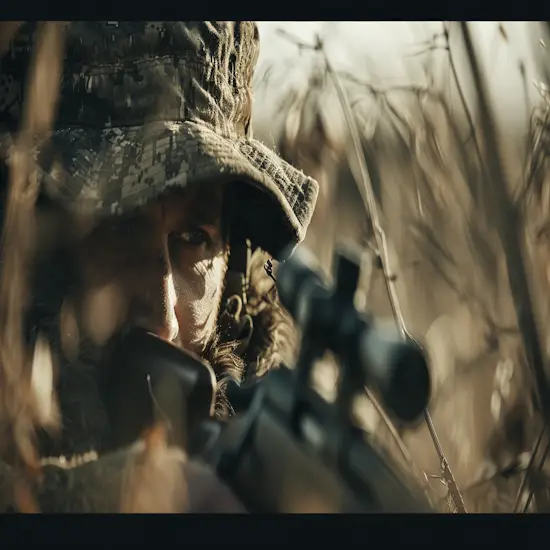
Shot Readiness and Execution
When aiming for a successful shot on a deer, remember the importance of shot placement. Quickly acquire your target, keep calm under pressure, and focus on follow-through technique.
Shot Placement Importance
Mastering shot placement is essential for successful deer hunting, ensuring your readiness and execution are on point for a successful hunt. Here are three key points to keep in mind:
- Study Deer Anatomy: Understanding where to aim for essential organs is critical for a quick and ethical kill. Practice visualizing the deer’s internal structure to improve your accuracy.
- Practice Shot Scenarios: Simulate different hunting situations to be prepared for varying angles and distances. This practice enhances your ability to make effective shots when the moment arises.
- Maintain Calmness: Stay composed and focused when taking the shot. Control your breathing, steady your aim, and execute the shot confidently for a higher chance of success.
Quick Target Acquisition
Quickly acquiring your target is essential for successful shot readiness and execution when hunting deer. To improve your quick target acquisition skills, practice scanning your surroundings efficiently from a good vantage point and staying alert for any movement.
Keep your eyes sharp and your focus steady, ready to aim at a moment’s notice. Position yourself for a clear shot, ensuring your firearm is steady and your aim is precise. Be prepared to adjust quickly if the deer moves, maintaining control over your movements.
Stay Calm Under Pressure
To maintain composure during pivotal moments of shot readiness and execution, it’s imperative to stay calm under pressure while hunting deer. Here are three key tips to help you succeed in staying calm under pressure:
- Control Your Breathing: Take slow, deep breaths to calm your nerves and focus your mind.
- Visualize Success: Mentally rehearse your shot and envision a successful outcome to boost your confidence.
- Stay Present: Focus on the present moment and the task at hand, avoiding distractions that may lead to anxiety or rushing.
Follow Through Technique
For better shot readiness and execution, ensure a smooth follow-through technique after releasing the trigger. A proper follow-through involves maintaining your shooting position, keeping your eyes on the target, and letting the recoil happen naturally.
By focusing on your follow-through, you guarantee that your shot is executed effectively and accurately. Remember to stay relaxed and avoid jerking the rifle after firing. This technique helps with shot placement and increases the chances of a successful hunt.
Practice this follow-through method consistently to improve your shooting skills and enhance your overall hunting experience. By mastering this technique, you can become a more proficient and successful deer hunter.

Clothing and Packing Tips
When preparing for deer hunting, it is important to wear appropriate clothing to stay comfortable and concealed. Make sure to pack efficiently, bringing only the gear you truly need. Select essential equipment that will aid in your success in the field.
Clothing Fabric Choices
Select wool as your go-to fabric for your hunting clothing to guarantee quiet movement in the field.
- Noise Reduction: Wool is naturally quiet, minimizing rustling sounds that could startle deer.
- Temperature Regulation: Wool keeps you warm even when wet, making it ideal for various weather conditions.
- Durability: Wool is durable and can withstand rough outdoor conditions, ensuring your clothing lasts.
Wool is an excellent choice for hunters due to its noise-reducing properties, temperature regulation, and durability. When selecting clothing for your hunting excursions, prioritize wool for a comfortable and effective hunting experience.
Efficient Packing Techniques
With your upcoming hunting trips in mind, make sure your packing techniques are efficient and strategic for a seamless experience in the field.
When it comes to clothing tips for efficient packing, remember to avoid guaranteeing overdressing. Opt for wool, as it’s the quietest fabric choice, and avoid bulky clothes that can hinder your movement.
Pack essentials in a fanny pack to keep things organized and easily accessible. Choose a fanny pack over noisy backpacks and ensure better load support with shoulder straps.
Essential Gear Selection
For efficient and strategic hunting trips, make sure your clothing and packing choices are optimized for success.
- Layer Up: Dress in layers to regulate body temperature and stay comfortable throughout the day.
- Pack Light: Only carry essential gear to minimize weight and maximize mobility in the hunting field.
- Choose Wisely: Opt for quiet and lightweight clothing and gear to avoid unnecessary noise and movement that could startle deer.
The Bottom Line
Still hunting for deer is commonly used by hunters when hunting. When still hunting for deer, hunters move slowly and blend in with the terrain. This makes the right camouflage clothing very important.
Natural cover and shadows are used to conceal your identity. Additionally, always stay alert and be mindful of the wind’s direction. In this article, we shared information about still hunting for deer to help you be more successful when still hunting for deer.
If you want to learn more about public vs private land deer hunting, then read this article. Additionally, you can also read pre-season preparation for deer hunting.